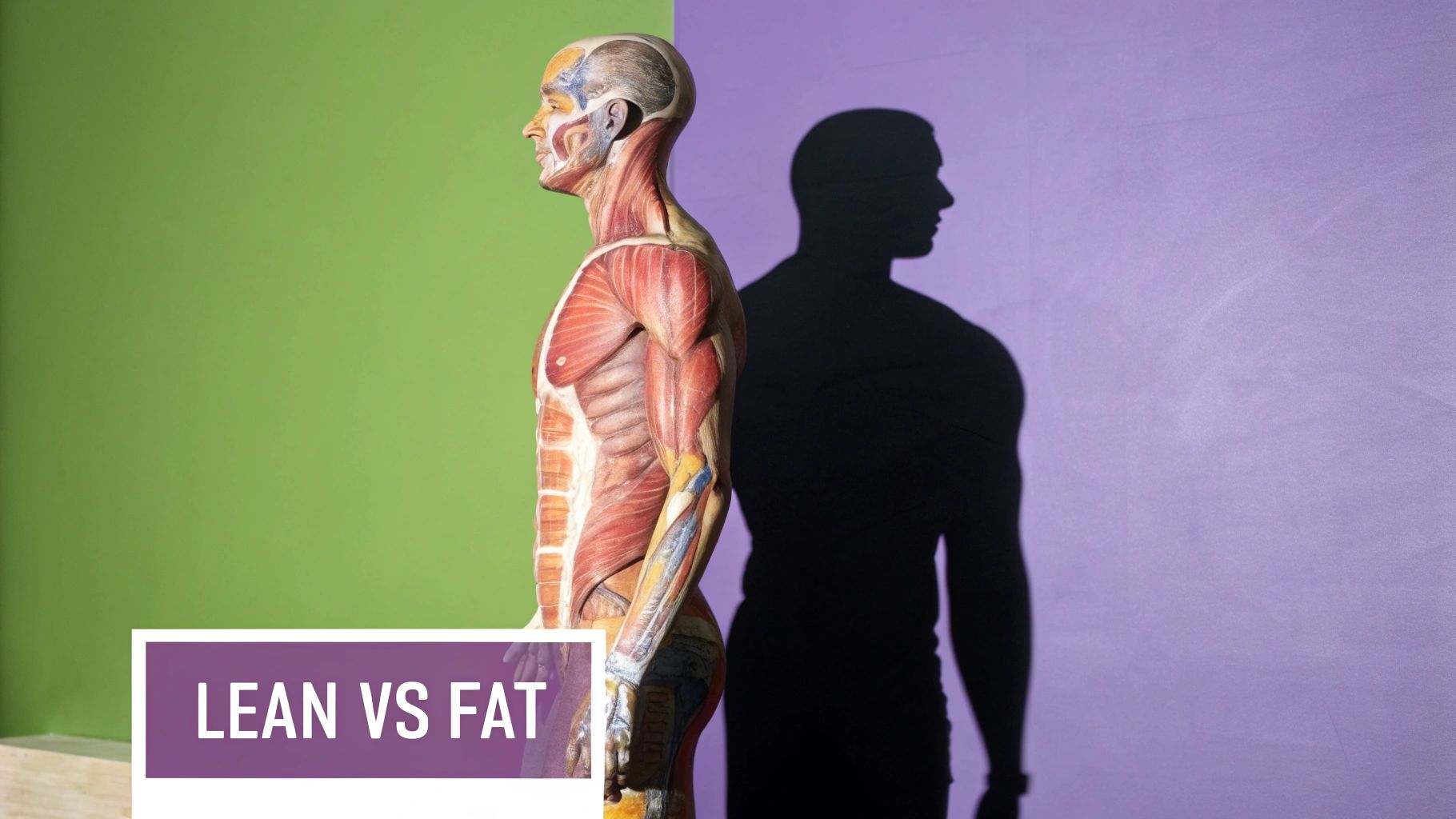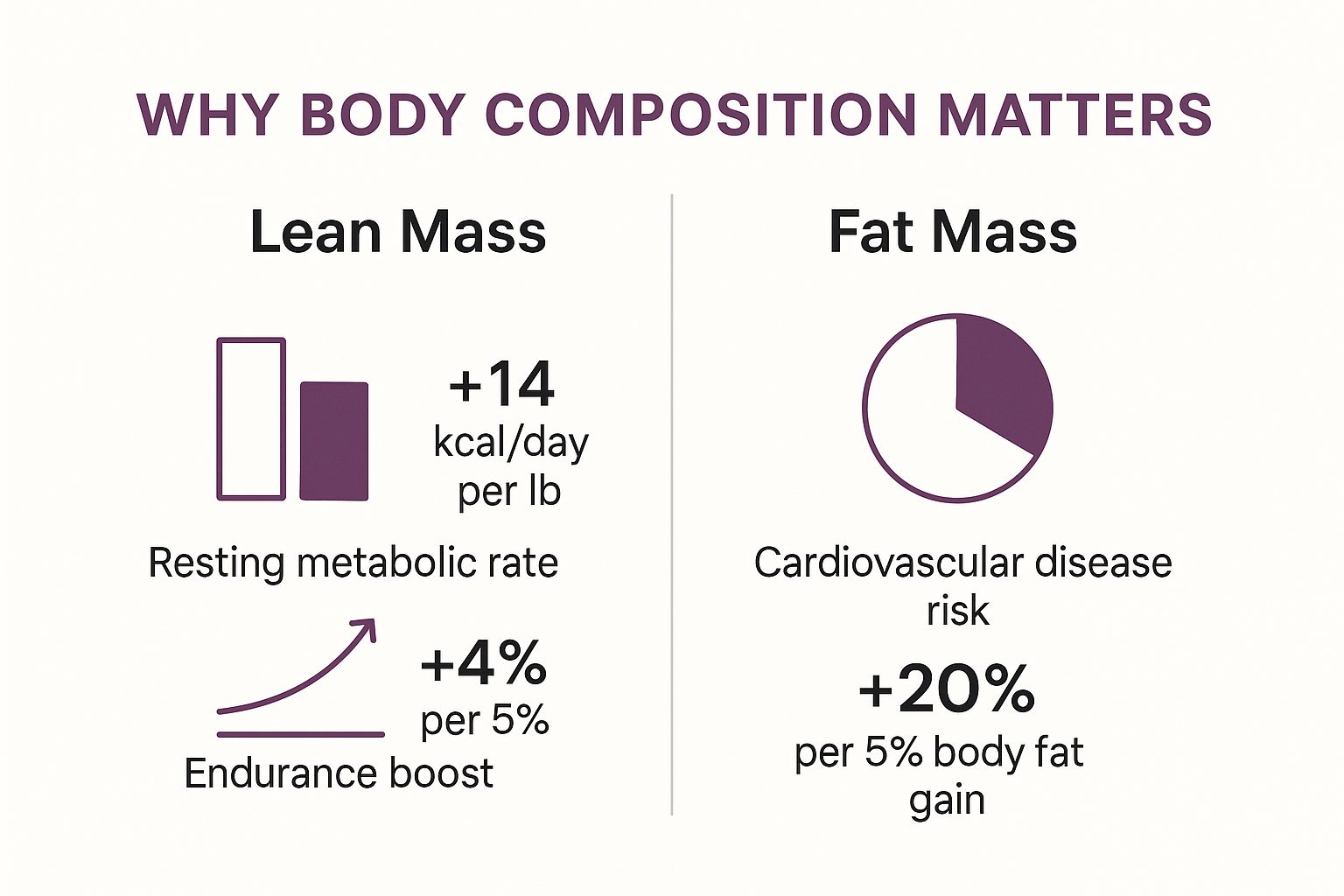
What Is Body Composition and Why It Matters
Body composition is a simple but incredibly powerful idea: it’s the ratio of fat mass to fat-free mass in your body.
It looks past the number on the bathroom scale to show you what your weight is actually made of, giving you a much truer picture of your health and fitness.
Understanding Your Body Beyond the Scale

Have you ever noticed how two people who weigh the exact same can look completely different? One might look lean and athletic, while the other appears softer and less toned.
This is body composition in a nutshell. It’s the perfect illustration of why the scale doesn't tell the whole story.
Your total body weight is a mix of two things: fat mass and fat-free mass.
Fat-free mass, often called lean mass, is basically everything else—your muscles, bones, water, and organs. Think of it as the active tissue that burns calories and powers you through your day.
The Two Core Components
Grasping the difference between fat and lean mass is the first real step toward setting meaningful fitness goals.
Instead of just chasing a lower number on the scale, a better goal is to lower your body fat while keeping—or even building—lean muscle. This strategy creates a stronger, healthier, and more resilient physique.
Let's break down these two key parts of your body composition.
A Quick Look at Body Composition
This table gives a simple summary of what makes up your body and why each part matters.
| Component | What It Includes | Its Role in Your Health |
|---|---|---|
| Fat Mass | Essential fat (for hormones) & storage fat | Provides energy reserves and protects organs |
| Fat-Free Mass | Muscle, bones, organs, and water | Drives your metabolism, provides strength, supports structure |
Knowing what's under the hood helps you target your efforts more effectively.
Body composition refers to the proportion of fat mass and fat-free mass in the human body, which includes muscles, bones, water, and organs. Its importance has grown significantly as we understand its direct link to health outcomes is far more telling than just weight or BMI. You can learn more about these health findings here.
This distinction is what it all comes down to. Losing weight by shedding muscle is a step backward, since muscle is the engine that drives your metabolism.
On the flip side, gaining muscle might make your scale weight go up, but it will improve your body composition, leaving you leaner and healthier overall.
As you get started on your fitness journey, having the right gear can make all the difference. Check out our line of inspiring fitness apparel to help you feel and perform your best.
Why BMI Can Be Misleading

For decades, Body Mass Index (BMI) has been the go-to metric for assessing health. It's a straightforward formula, using just your height and weight to slot you into a category: 'underweight,' 'normal,' or 'overweight.'
But its simplicity is also its biggest weakness.
The problem? BMI has no idea what your body is actually made of. It can't tell the difference between a pound of dense, powerful muscle and a pound of fluffy, space-hogging fat.
This means a highly conditioned athlete, packed with lean muscle, could easily be flagged as 'overweight' by a BMI chart. It's a classic case of how the scale can lie.
Seeing Beyond the Numbers
On the flip side, you have the "skinny fat" phenomenon. Someone might have a perfectly 'normal' BMI, but their body could be composed of very little muscle and a high percentage of body fat.
Despite their "healthy" weight, they can still face the same health risks tied to excess fat, like metabolic problems. This is where BMI completely misses the mark.
A person's health is far too complex to be summed up by a simple height-to-weight ratio. Body composition gives you a much truer picture of your metabolic health, disease risk, and genuine fitness level.
This is exactly why getting a handle on what is body composition is so crucial. It moves the conversation away from an outdated number and toward a personalized look at what's really going on inside your body.
It helps you set meaningful goals, like building strength and shedding unhealthy fat, rather than just chasing a number on the scale.
A Smarter Approach to Health
When you start tracking your body composition, you gain incredible clarity on whether your efforts are paying off. Are you actually losing fat while holding onto precious, metabolism-boosting muscle?
A smart scale can offer a far more insightful story than your old bathroom scale ever could.
If you're looking for a great tool to get started, the Smart Body Fat Scale is a fantastic option. It gives you a convenient way to see the real story of your progress right at home. By focusing on the metrics that matter, you can make sure your hard work is building a truly healthier body.
The Two Sides of Body Composition

When we talk about body composition, we're breaking the body down into its two core components: fat mass and lean mass.
Understanding the difference is the key to unlocking real, sustainable health goals that go way beyond what the bathroom scale tells you.
Let's start with fat. It often gets a bad rap, but your body needs some of it to survive. This is called essential fat, and it plays a vital role in protecting your organs and regulating hormones.
The type of fat we need to watch is storage fat. More specifically, visceral fat—the kind hidden deep within your abdominal cavity, wrapped around your vital organs. High levels of this internal fat are strongly linked to serious health risks.
Your Body's Engine: Lean Mass
Now for the other side of the coin: lean mass. Think of this as everything in your body that isn't fat. It's your metabolic engine.
Lean mass is made up of a few key things:
- Muscle: This is the big one. Your muscles are metabolically active, meaning they burn calories even when you're just sitting on the couch. The more muscle you have, the higher your resting metabolism.
- Bone: Your skeleton is your body's framework. It provides structure and keeps your organs safe.
- Water: A huge percentage of your body is water. It's essential for almost every process, from nutrient transport to keeping your temperature in check.
This is why you can drop a pants size and look noticeably leaner, even if the scale hasn't budged.
When you focus on building muscle and shedding excess fat, you're fundamentally changing your body's makeup. You’re building a healthier, more efficient machine from the inside out.
It’s a powerful shift in perspective—from chasing a lower weight to building a stronger body. If you want a great primer on tracking these changes, this DietExercise YouTube channel offers practical tips on how to use a smart scale to get reliable readings.
How to Accurately Measure Body Composition
Okay, so you're sold on the idea that body composition is a far better health marker than just the number on a scale. That's a huge step.
The next logical question is: "How do I figure out my numbers?"
You've got options, ranging from simple at-home tools to incredibly precise lab scans. Each one strikes a different balance between accuracy, cost, and convenience.
Common At-Home Measurement Tools
For most of us, the best tools are the ones we can use consistently at home. Two of the most common are Bioelectrical Impedance Analysis (BIA) scales and skinfold calipers.
BIA scales are super convenient. They send a tiny, safe electrical current through your body. Fat, muscle, and water resist this current differently, allowing the scale to estimate your body fat percentage.
Skinfold calipers are a more hands-on approach. You use the tool to gently pinch a fold of skin—and the underlying fat—at specific points on your body. You then plug those measurements into a formula to estimate your total body fat.
The image below shows why keeping an eye on these numbers is so critical. It highlights how differently lean mass and fat mass impact your overall health.

As you can see, building lean mass is a game-changer for your metabolism and energy. On the flip side, higher levels of fat mass are directly linked to increased health risks.
Gold-Standard Clinical Methods
If you need the highest degree of accuracy, you'll want to look at clinical methods. The DEXA (Dual-Energy X-ray Absorptiometry) scan is widely considered the gold standard. It uses low-dose X-rays to give a detailed picture of your fat, muscle, and bone density.
Another precise technique is hydrostatic weighing. This involves being submerged in a special tank of water. By measuring how much water you displace, technicians can calculate your body's density and body fat percentage.
Comparing Body Composition Measurement Tools
Choosing the right tool can feel overwhelming. Here’s a quick side-by-side comparison to help you find the best fit.
| Method | How It Works | Accuracy Level | Cost & Accessibility |
|---|---|---|---|
| BIA Scales | Sends a weak electrical current through the body to measure impedance. | Moderate | Low cost, very accessible for home use. |
| Skinfold Calipers | Measures the thickness of subcutaneous fat at specific body sites. | Moderate to High (if done by a skilled person). | Very low cost, but technique matters a lot. |
| DEXA Scan | Uses low-dose X-rays to differentiate between bone, fat, and lean mass. | Very High (Gold Standard) | High cost, requires a clinical setting. |
| Hydrostatic Weighing | Measures body density by submerging a person in water. | Very High | High cost, very limited availability. |
For most people, the "best" method is the one you'll use consistently. A Smart Body Fat Scale is more than enough to track trends over time, which is what truly matters.
People are paying more attention to these detailed health metrics. The market for body composition analyzers was valued at around USD 2.65 billion in 2025. It's projected to grow by over 15.8% each year. If you're curious, you can learn more about this growing market.
How to Improve Your Body Composition
You've got your body composition numbers. What now? Knowing the data is just the starting line. The real magic happens when you use that information to build a stronger, healthier body.
Improving your body composition comes down to a simple strategy: reduce excess body fat while you build or maintain lean muscle mass.
Building muscle cranks up your metabolism, meaning you burn more calories around the clock. This makes losing fat that much easier.
Diet and Exercise Habits for Your Goals
Your diet and workout plan are the tools you'll use to change your body. The key is to combine them effectively.
Think of your diet as the fuel for building a new you. The most important nutrient is lean protein. Foods like chicken, fish, beans, and tofu are crucial for repairing and growing muscle after a workout. Protein also keeps you feeling full, which helps with managing calories.
For exercise, nothing beats the one-two punch of strength training and cardio.
-
To Build Muscle and Lose Fat (Body Recomposition): Combine resistance training with a high-protein diet. Lifting weights, using bands, or doing bodyweight exercises like push-ups tells your body to build muscle. Aim for 2-3 sessions per week. A small, consistent calorie deficit signals your body to burn fat for energy. Our guide on what is a calorie deficit breaks this down.
-
To Maximize Fat Loss: Increase your cardiovascular activity. Getting your heart rate up with running, cycling, or brisk walking is fantastic for burning calories. Aim for 150 minutes of moderate-intensity cardio each week, alongside your strength training, while maintaining that protein intake and slight calorie deficit.
The best plan is one you can stick with. Forget fads and focus on whole foods—fruits, vegetables, lean proteins, and whole grains. They give you steady energy and the nutrients you need.
Got Questions About Body Composition? We've Got Answers.
Alright, let's tackle a few of the questions that might still be rattling around in your head.
Can You Really Lose Fat and Build Muscle at the Same Time?
Absolutely. This goal, often called body recomposition, is totally achievable, especially if you're relatively new to lifting weights.
The trick is to eat enough protein to give your muscles the raw materials they need to grow, all while maintaining a slight calorie deficit. This encourages your body to use its fat reserves for energy.

So, How Often Should I Check My Body Composition?
Patience is key here. Body composition shifts much more slowly than the number on the scale.
For a more accurate and motivating picture of your progress, aim to measure it every 4 to 8 weeks. Just be sure to do it under the same conditions each time—like first thing in the morning, on an empty stomach.
Remember, consistency trumps frequency. You're looking for long-term trends over months, not the tiny fluctuations that happen day-to-day.
What Exactly Is "Skinny Fat"?
"Skinny fat" describes someone who has a "normal" body weight or BMI, but actually has a high percentage of body fat and very little muscle.
This is the perfect illustration of why knowing what is body composition is so much more valuable than just tracking weight.
A "skinny fat" profile can carry similar health risks to being overweight, because the danger lies in the excess fat, not the total pounds.
For more practical guides on fitness and nutrition, head over and check out the other articles on our DietExercise blog.
At DietExercise, we know that the right mindset is the foundation for a healthier life. Our apparel and accessories are here to keep you inspired and focused on your path. Take a look at the full collection at dietexerciseshop.com.
